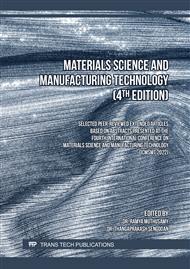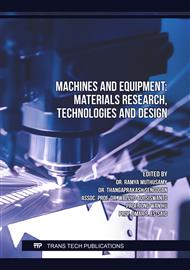[1]
A. Bhattacharya, T.K. Bera, Development of automatic GMAW setup for process improvements: experimental and modeling approach, Mater. Manuf. Process. 29 (2014) 988-995.
DOI: 10.1080/10426914.2014.892611
Google Scholar
[2]
J. Xiong, G. Zhang, J. Hu, L. Wu, Bead geometry prediction for robotic GMAW-based rapid manufacturing through a neural network and a second-order regression analysis, J. Intell. Manuf. 25 (2014) 157-163.
DOI: 10.1007/s10845-012-0682-1
Google Scholar
[3]
K. Micallef, G. Fang, M. Dinham, Automatic Seam Detection and Path Planning in Robotic Welding. In: Tarn, T.J., Chen, S.B., Fang, G. (Eds.), Robotic Welding, Intelligence and Automation. Lecture Notes in Electrical Engineering, Springer, Berlin, Germany, 2011 vol. 88, pp.23-32.
DOI: 10.1007/978-3-642-19959-2_3
Google Scholar
[4]
I.S. Kim, J.S. Son, C.E. Park, I.J. Kim, H.H. Kim, An investigation into an intelligent system for predicting bead geometry in GMA welding process, J. Mater. Process. Technol. 159 (2005) 113-118.
DOI: 10.1016/j.jmatprotec.2004.04.415
Google Scholar
[5]
H.C. Wikle, S. Kottilingam, R.H. Zee, B.A. Chin, Infrared sensing techniques for penetration depth control of the submerged arc welding process, J. Mater. Process. Technol. 113 (2001) 228-233.
DOI: 10.1016/s0924-0136(01)00587-8
Google Scholar
[6]
I.S. Kim, K.J. Son, Y.S. Yang, P.K.D.V. Yaragada, Sensitivity analysis for process parameters in GMA welding processes using a factorial design method, Int. J. Mach. Tools Manuf. 43 (2003) 763-769.
DOI: 10.1016/s0890-6955(03)00054-3
Google Scholar
[7]
Y. Xu, G. Fang, S. Chen, J.J. Zou, Z. Ye, Real-time image processing for vision-based weld seam tracking in robotic GMAW, Int. J. Adv. Manuf. Technol. 73 (2014) 1413-1425.
DOI: 10.1007/s00170-014-5925-1
Google Scholar
[8]
D. Xu, M. Tan, X. Zhao, Z. Tu, Seam Tracking and Visual Control for Robotic Arc Welding Based on Structured Light Stereovision, Int. J. Autom. Comput. 1 (2004) 63-75.
DOI: 10.1007/s11633-004-0063-0
Google Scholar
[9]
H.R. Ghazvinloo, A.H. Raouf, N. Shadfar, Effect of the electrode to work angle, filler diameter and shielding gas type on weld geometry of HQ130 steel joints produced by robotic GMAW, Indian J. Sci. Technol. 3 (2010) 26-30.
DOI: 10.17485/ijst/2010/v3i1.19
Google Scholar
[10]
Y. Xu, G. Fang, N. Lv, S. Chen, J.J. Zou, Computer vision technology for seam tracking in robotic GTAW and GMAW. Robot, Comput. Integr. Manuf. 32 (2015) 25-36.
DOI: 10.1016/j.rcim.2014.09.002
Google Scholar
[11]
D. Ding, Z.S. Pan, D. Cuiuri, H. Li, A tool-path generation strategy for wire and arc additive manufacturing, Int. J. Adv. Manuf. Technol. 73 (2014) 173-183.
DOI: 10.1007/s00170-014-5808-5
Google Scholar
[12]
D. Ding, Z. Pan, D. Cuiuri, H. Li, A practical path planning methodology for wire and arc additive manufacturing of thin-walled structures, Robot. Comput. Integr. Manuf. 34 (2015) 8-19.
DOI: 10.1016/j.rcim.2015.01.003
Google Scholar
[13]
S.H. Suh, I.K. Woo, S.K. Noh, Automatic trajectory planning system (ATPS) for spray painting robots, J. Manuf. Syst. 10 (1991) 396-406.
DOI: 10.1016/0278-6125(91)90057-9
Google Scholar
[14]
M.V. Andulkar, S.S. Chiddarwar, A.S. Marathe, Novel integrated offline trajectory generation approach for robot assisted spray painting operation, J. Manuf. Syst. 37 (2015) 201-216.
DOI: 10.1016/j.jmsy.2015.03.006
Google Scholar
[15]
H. Moon, J. Kim, Intelligent crack detecting algorithm on the concrete crack image using neural network. In: Proceedings of the 28th ISARC, Seoul, Korea, 2011, pp.1461-1467.
DOI: 10.22260/isarc2011/0279
Google Scholar



